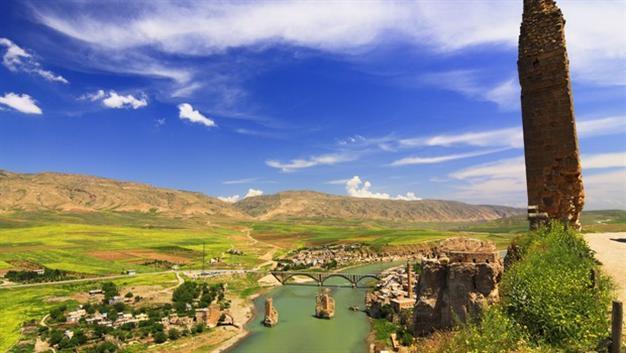Hasankeyf: City of rocks, castles, bridges, minarets…
Ertuğrul Günay
 With its natural, historical and architectural features, Hasankeyf is very different from many ruins in Anatolia, for example, the Eastern Roman ruins. As Archaeological News said, it is a unique settlement. However, the structures in Hasankeyf are not durable enough to overcome flooding. Hasankeyf, which hosted many ancient civilizations, is anxiously waiting for a flood…
With its natural, historical and architectural features, Hasankeyf is very different from many ruins in Anatolia, for example, the Eastern Roman ruins. As Archaeological News said, it is a unique settlement. However, the structures in Hasankeyf are not durable enough to overcome flooding. Hasankeyf, which hosted many ancient civilizations, is anxiously waiting for a flood…Hasankeyf is a small town on the Tigris River. Once, it was connected to Mardin province, now it is connected to Batman, which became a province in 1990. It is a small and quiet town with a few thousand people. Hasankeyf is not only one of most interesting settlements in its immediate geography, Turkey’s southeast, but also among all Anatolian settlements.
According to the discoveries made in the area, its history dates back past 9,000 B.C. There are thousands of caves in the city, and while its rock structure creates natural caves, people from different eras also built in the area, competing castles, bridges, mosques and shrines.
The town’s name comes from the glaring effect of this natural structure. Hasankeyf is really a city of rocks when you look around it. The word “kefa” means “rock” in Aramaic, and it was used in a similar meaning in different periods; the Romans called it “Castrom Kapa,” Arabs, having the same meaning, called it “Hısn-ı Kayfa.”
Hasankeyf, which is an important gateway on the Tigris, has witnessed many battles in history.
The Sassanids, the Romans, the Assyrians, the Arabs, the Artuqid Turks, the Ayyubid Kurds, the Mongols, the Akkoyunlus and finally the Ottomans ruled this city of rocks. All of these different managements left traces in Hasankeyf. For example, in the interior castle called “Top City,” there are structural traces of the Urartus and the Romans. The palace, of which only the foundation remains, the Grand Mosque and the baths were examples of the Artuqid’s architecture. The Sultan Suleyman, Koç and El Rızk mosques belong to the Ayyubid’s architecture and the Zeynelbey Tomb, with its interesting architecture and decorations, belongs to the Akkoyunlus.
The tomb of Imam Abdullah, who was considered to be close to Prophet Mohammed, was built by Artuk in 651, according to the Islamic calendar, and it was repaired in the Ayyubid period.
Not only did the Mongols build new artwork in Hasankeyf, which was a magnificent city when they invaded, but they also destroyed the city. In the aftermath of the Mongol’s destruction, the Ayyubids tried to repair the settlement. The Ottomans never harmed Hasankeyf, however they did not try to repair or improve the settlement. Therefore, Hasankeyf, with its thousands of years of history and heritage beside the Tigris, has stood on its own against all destruction.
Today, this ancient city is part of an important debate. Hasankeyf is located in the basin of the Ilısu Dam, which is under construction. As the dam collects water, all the historical monuments, ancient settlements and areas except for the “Upper Town” will be destroyed by the floods. Therefore, World Cultural Heritage officials named Hasankeyf an “under threat settlement.” The local people of Hasankeyf are humorless, bitter and sad while waiting for the flood.
The Ilısu Dam Project, which was planned under Southeastern Anatolia Project’s investments, was begun in the 1960s, completed in the 1980s and tendered in 1997. The damage potentially caused by the dam’s construction has been discussed for a quarter of a century.
Local people, authorities, experts in archeology and volunteers who have cultural and environmental sensitivity support a change in the project, lowering the water level and thus saving Hasankeyf from being destroyed. However, the owner of the project and executive and public units who are responsible and competent in the case of water and energy do not listen to these complaints and refuse to change the project. In contrast, they are supporting a large number of archaeological surveys and archaeological excavations in the basin of the dam and building a new settlement, public buildings and residences near Hasankeyf. Besides, they proposed demonstrating portable works in this new city. They even initiated a large museum building, which has not yet been taken over by the Culture and Tourism Ministry.
The Culture and Tourism Ministry has brought up an inventory of all the historical monuments in the area as a precaution against the risk of flooding, detected and documented all the monuments and carried out scientific studies in order to save Hasankeyf.
These days, Hasankeyf witnesses an unarmed and silent war between those who consider that a civilization is just about roads and dams and those who believe that a civilization, with its nature and history, is more than just roads and dams. I hope that the winner at the end of the war will be Hasankeyf and wish the ancient civilization’s traces will never disappear.
















